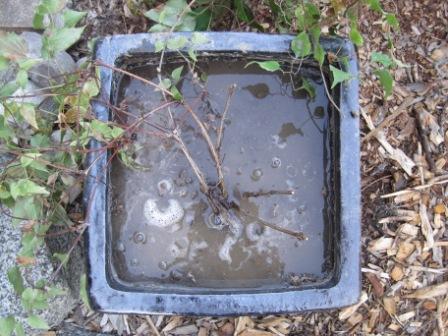Friday’s puzzle was tricky! I will preface the answer by saying I don’t do a lot of container plants except for annuals. When I plant up annuals into soilless potting mix (which is dehydrated), I work in the water thoroughly into this fluffy medium. Friday’s situation was a little different. The Clematis are more or less permanent residents in these planters, so I use real soil rather than potting mix. (This will reduce or eliminate the shrinkage you’ll get if you use soilless media, as these highly organic materials steadily decompose.)
But what I thoughtlessly did was to mix water into my nice screened clay loam like it was a potting mix. The result of vigorous mixing is to break down the soil structure and drive water into all of the pore spaces, resulting in a totally waterlogged soil:

After my "D’oh" moment when I realized my error, I potted the second Clematis into loose soil and let gravity work the water into the larger pore spaces. This passive approach protected the soil structure and left some of the pore spaces filled with air rather than water, so that the water drained through rather than sitting on top of the compacted soil:

This demonstrates one of the rules of working with landscape soils: you should avoid any potential compaction when the soil is wet. (It’s the same reason you shouldn’t stomp on wet backfill as you’re transplanting trees and shrubs.) As Ginny pointed out, you’ll create a cement-like structure – not conducive for water movement, oxygen availability, or root growth.
Great pair of posts! I thought that soil structure was going to be part of the answer (easy to say after you’ve published the answer, no? But really, it’s true!), and showing it this way makes it completely clear, and completely clear also why to keep anyone from stomping on the soil around newly planted trees and shrubs. Did you dig out the first clematis and replant it without mixing?
Oh yes, Deb! After my first clematis sat sadly while I took pictures, I dug it out of the waterlogged mess and did it right. The wet soil is sitting in a wheelbarrow, and once it dries again I’ll sieve it and store.
The idea of “mixing” water into potting soil gives me visions of the witch scene from MacBeth but with several gardeners standing over a big cauldron of potting mix and water intoning, “Double, double this soil and save my plants from trouble…”
And it does seem like a lot of mess and trouble. Is mixing in water really more effective, or better in some way, than watering the mix and letting it soak for a bit in a bucket?
Great visualization there, Paige! The mixes I use are so light and dehydrated that they float on top of the water. You’re right, though, that I could let it sit for a while and eventually it would sink. I just choose to hurry things up a bit (since I always seem to be doing these things at the last minute).